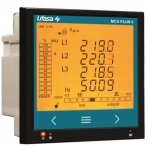Main Functions and Types of Reactive Power Compensation Devices:
Compensation Capacitors:
Used to compensate for reactive power in industrial facilities, offices, and electrical networks.
They reduce current consumption from the power grid, optimizing energy usage.
Often installed directly next to electrical motors or other inductive loads.
Automatic Power Factor Correction (PFC) Systems:
These are smart systems that automatically adjust the operation of capacitors or other devices based on grid demand.
They help maintain a stable and high power factor, preventing unnecessary energy losses.
SVC (Static Var Compensators):
Advanced electronic devices used in large electrical systems that regulate reactive power flow in real-time to maintain stable voltage levels.
Commonly used in power transmission lines and industrial systems that require rapid and dynamic compensation.
Hybrid Compensation Solutions:
A combination of capacitor banks and electronic devices aimed at increasing efficiency and response speed to changing power grid loads.
Benefits and Applications:
Lower Energy Losses: Compensation devices help reduce the overall amount of electrical current traveling through the grid, minimizing losses in cables and transformers.
Improvement of Power Factor: This reduces penalties that electricity suppliers may impose for low power factor.
Stable Voltage Levels: Properly selected compensation devices help maintain a constant voltage, reducing voltage fluctuations that can cause equipment failures.
Reactive power compensation devices are essential for both small businesses and large industrial enterprises, as they help optimize energy consumption and ensure efficient system operation.




